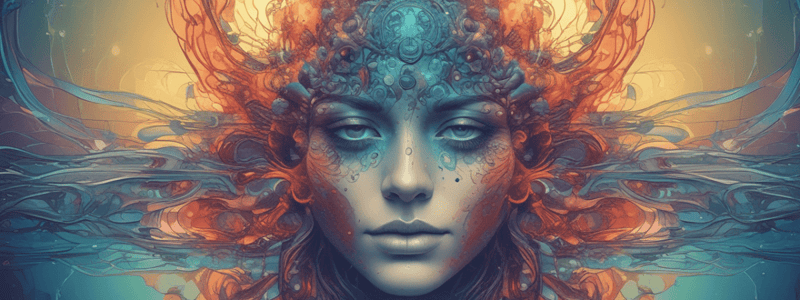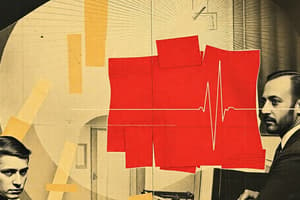Podcast
Questions and Answers
What is the primary reaction to cold?
What is the primary reaction to cold?
- Feeling hot
- Feeling cold (correct)
- Circulation increase
- Metabolism increase
What is the primary reaction to heat?
What is the primary reaction to heat?
- Feeling hot (correct)
- Feeling cold
- Circulation increase
- Metabolism increase
What is the gate theory regulated by?
What is the gate theory regulated by?
- Nervous System
- Pain receptors
- Nociceptors (correct)
- Endocrine system
What are the two numbers in a blood pressure reading?
What are the two numbers in a blood pressure reading?
What are the effects of prolonged use of cold?
What are the effects of prolonged use of cold?
Flashcards are hidden until you start studying
Study Notes
- The body regulates homeostasis by attempting to return the body to core temperature.
- Results occur at safe temperatures above or below that of the area being attended to and become more profound as the difference increases.
- The thermal effect is the result of the application of water at temperature either above or below of the normal body temperatures.
- Chemical effects are produced when taken by mouth or cavity irrigation.
- Mechanical Effects are produced by actual impact of water on the surrounding tissues and skin surface.
- Hot and Cold - Effects of the Reflex Arc - Nervous System
- As we have learned, both hot and cold can have reflex effects on the body due to the actions of the nervous system.
- These effects can be experienced by the muscular system, circulatory system, or the endocrine system.
- A sufficiently intense local application of heat or cold to the skin surface not only affects the immediate skin area, but also exerts remote effects elsewhere in the body through the nervous system.
- The reflex effects are the automatic involuntary neural pathway response to a hot or cold stimulus mediated through the Nervous System creating either a localized or systemic sensory neuron effect.
- Thermoreceptors are sensory receptors that pick up and respond to alterations in hot or cold temperatures.
- Select the “more information” button for a further explanation of the reflex arc.
- The effects are mediated through a reflex arc made up of an afferent nerve fiber from the skin surface which carries the stimulus to the spinal cord through the posterior nerve root. Here it is communicated through synapses to an efferent autonomic fiber leaving the spinal cord through an anterior spinal nerve root, ultimately causing a reflexive effect.
- The gate theory is regulated by the Nervous System’s pain signals and mediated by pain receptors or nociceptors.
- Cold applications example would be to decrease the signal to the pain receptors and reduce pain.
- Decreases inflammation during tissue repair phase.
- The greater the difference between body and hydrotherapy application temperatures, the greater the effect.
- High blood pressure is a condition in which the pressure of blood against the walls of the arteries is higher than normal.
- The top number known as the systolic pressure reflects the pressure in the blood vessels when the heart contracts and forces blood into the system. The bottom number known as the diastolic pressure reflects the pressure in the vessels when the heart is at rest.
- Between these beats the chambers of the heart will dilate and fill with blood.
- Blood pressure readings consist of two numbers, one over top of the other.
- Sustained high range metrics indicate hypertension.
- Hydrotherapy can change the body's physiological chemistry when applied at different temperatures and various mechanical means.
- Hydrotherapy is an important part of health care without the use of prescription medications.
- Hot and cold applications have a stimulating effect on reflexology related tissues and organs.
- The primary reaction to cold is just the initial feeling of being cold. The effects include circulation reduced, metabolism is reduced, and the person appears pale. The secondary effect is to feel warm. The secondary effects are circulation is increased, metabolism is increased and the person appears red. The primary reaction to heat is the person feeling hot. The effects are circulation increase, metabolism increase, and the person appears red. The secondary reaction is to feel cooler. The secondary effects are circulation reduces, metabolism reduces, and the person appears paler.
- Cold treatments are generally associated with acute diseases and inflammatory conditions such as: arthritis, strains, sprains, bruises, and pneumonia.
- Cold applications improve circulation, stimulate nerves, and improve functional activity of cells as a secondary effect. Prolonged use of cold should be avoided because, as mentioned, produces a depressing effect.
- Indications for cold treatment are as follows: Redness or hyperemia, engorgement such as swelling or inflammation, pain, fever, heat, loss of function, and finally poor metabolism.
Studying That Suits You
Use AI to generate personalized quizzes and flashcards to suit your learning preferences.




